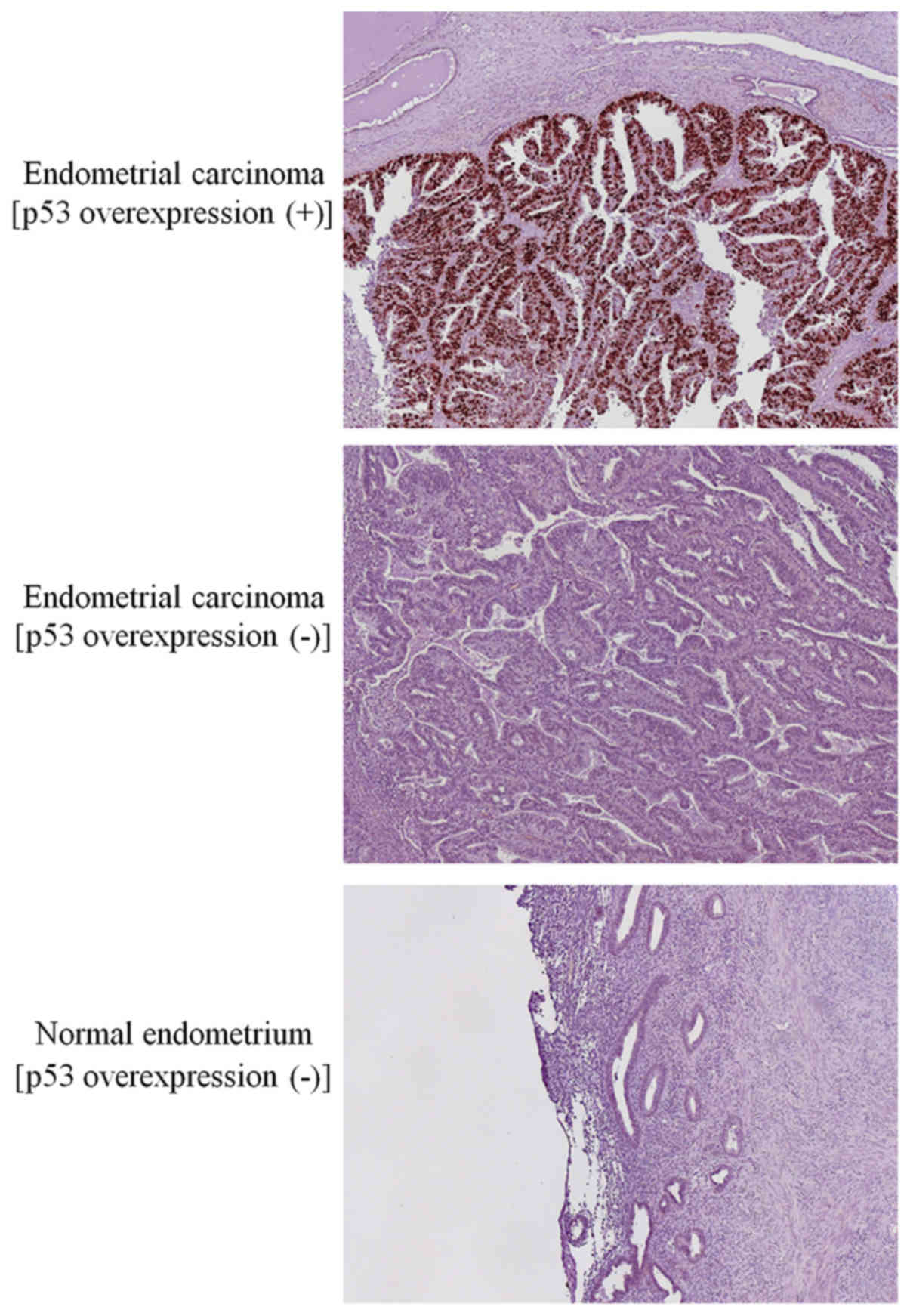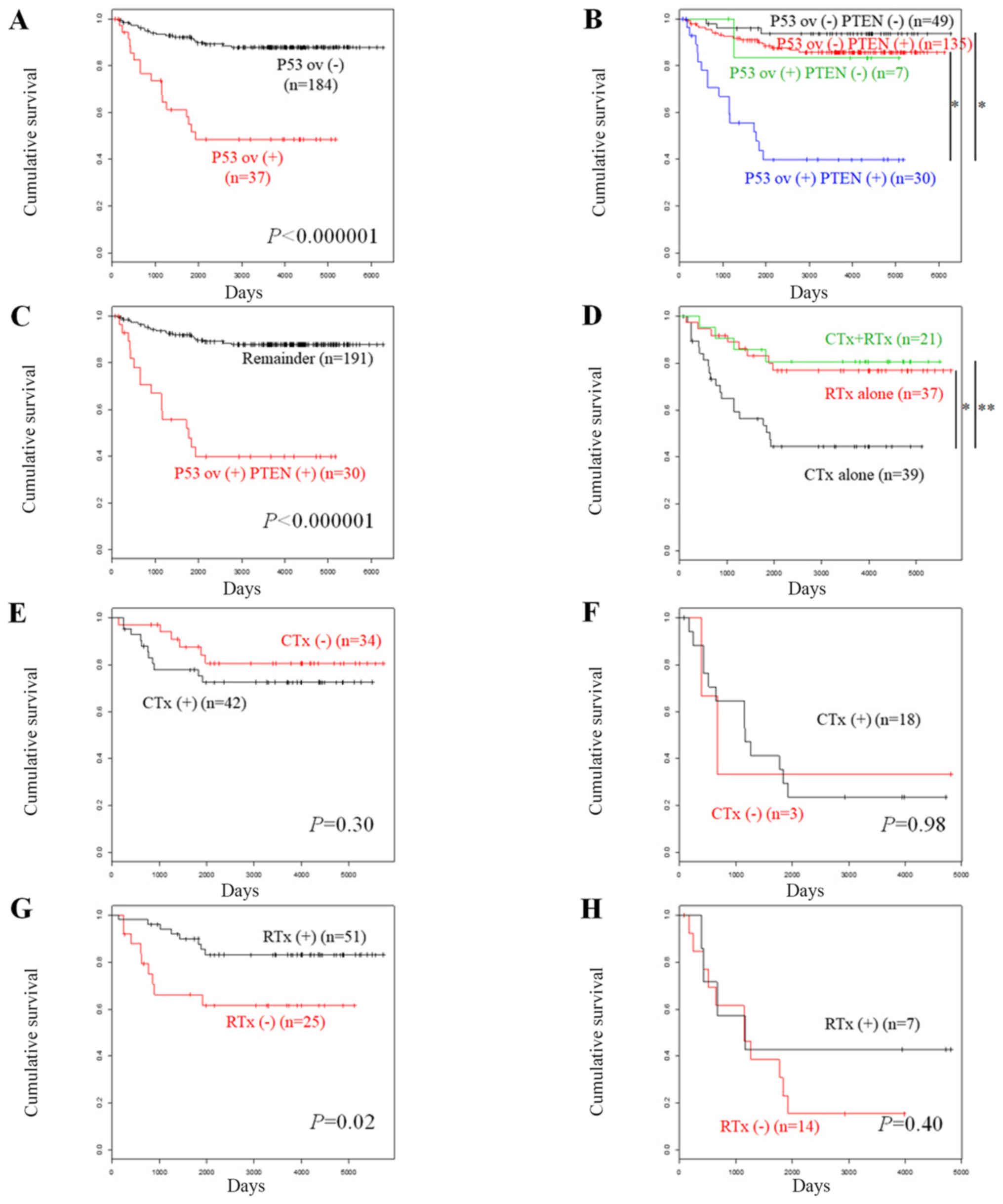|
1
|
Ferlay J, Colombet M and Bray F: GLOBOCAN
2018. International Agency for Research on Cancer, Lyon, France.
2018.
|
|
2
|
Minaguchi T, Yoshikawa H, Oda K, Ishino T,
Yasugi T, Onda T, Nakagawa S, Matsumoto K, Kawana K and Taketani Y:
PTEN mutation located only outside exons 5, 6, and 7 is an
independent predictor of favorable survival in endometrial
carcinomas. Clin Cancer Res. 7:2636–2642. 2001.PubMed/NCBI
|
|
3
|
Akiyama-Abe A, Minaguchi T, Nakamura Y,
Michikami H, Shikama A, Nakao S, Sakurai M, Ochi H, Onuki M,
Matsumoto K, et al: Loss of PTEN expression is an independent
predictor of favourable survival in endometrial carcinomas. Br J
Cancer. 109:1703–1710. 2013. View Article : Google Scholar : PubMed/NCBI
|
|
4
|
Muller PA and Vousden KH: P53 mutations in
cancer. Nat Cell Biol. 15:2–8. 2013. View
Article : Google Scholar : PubMed/NCBI
|
|
5
|
Deneberg S, Cherif H, Lazarevic V,
Andersson PO, von Euler M, Juliusson G and Lehmann S: An open-label
phase I dose-finding study of APR-246 in hematological
malignancies. Blood Cancer J. 6:e4472016. View Article : Google Scholar : PubMed/NCBI
|
|
6
|
Lehmann S, Bykov VJ, Ali D, Andrén O,
Cherif H, Tidefelt U, Uggla B, Yachnin J, Juliusson G, Moshfegh A,
et al: Targeting p53 in vivo: A first-in-human study with
p53-targeting compound APR-246 in refractory hematologic
malignancies and prostate cancer. J Clin Oncol. 30:3633–3639. 2012.
View Article : Google Scholar : PubMed/NCBI
|
|
7
|
Li D, Marchenko ND and Moll UM: SAHA shows
preferential cytotoxicity in mutant p53 cancer cells by
destabilizing mutant p53 through inhibition of the HDAC6-Hsp90
chaperone axis. Cell Death Differ. 18:1904–1913. 2011. View Article : Google Scholar : PubMed/NCBI
|
|
8
|
Yan W, Liu S, Xu E, Zhang J, Zhang Y and
Chen X: Histone deacetylase inhibitors suppress mutant p53
transcription via histone deacetylase 8. Oncogene. 32:599–609.
2013. View Article : Google Scholar : PubMed/NCBI
|
|
9
|
Kravchenko JE, Ilyinskaya GV, Komarov PG,
Agapova LS, Kochetkov DV, Strom E, Frolova EI, Kovriga I, Gudkov
AV, Feinstein E and Chumakov PM: Small-molecule RETRA suppresses
mutant p53-bearing cancer cells through a p73-dependent salvage
pathway. Proc Natl Acad Sci USA. 105:6302–6307. 2008. View Article : Google Scholar : PubMed/NCBI
|
|
10
|
Pecorelli S: Revised FIGO staging for
carcinoma of the vulva, cervix, and endometrium. Int J Gynaecol
Obstet. 105:103–104. 2009. View Article : Google Scholar : PubMed/NCBI
|
|
11
|
Abe A, Minaguchi T, Ochi H, Onuki M, Okada
S, Matsumoto K, Satoh T, Oki A and Yoshikawa H: PIK3CA
overexpression is a possible prognostic factor for favorable
survival in ovarian clear cell carcinoma. Hum Pathol. 44:199–207.
2013. View Article : Google Scholar : PubMed/NCBI
|
|
12
|
Berchuck A and Boyd J: Molecular basis of
endometrial cancer. Cancer. 76:2034–2040. 1995. View Article : Google Scholar : PubMed/NCBI
|
|
13
|
Zhang J, Shen L and Sun LQ: The regulation
of radiosensitivity by p53 and its acetylation. Cancer Lett.
363:108–118. 2015. View Article : Google Scholar : PubMed/NCBI
|
|
14
|
Concin N, Zeillinger C, Stimpfel M,
Schiebel I, Tong D, Wolff U, Reiner A, Leodolter S and Zeillinger
R: P53-dependent radioresistance in ovarian carcinoma cell lines.
Cancer Lett. 150:191–199. 2000. View Article : Google Scholar : PubMed/NCBI
|
|
15
|
Dey S, Spring PM, Arnold S, Valentino J,
Chendil D, Regine WF, Mohiuddin M and Ahmed MM: Low-dose
fractionated radiation potentiates the effects of Paclitaxel in
wild-type and mutant p53 head and neck tumor cell lines. Clin
Cancer Res. 9:1557–1565. 2003.PubMed/NCBI
|
|
16
|
Ohnishi K, Inaba H, Yasumoto J, Yuki K,
Takahashi A and Ohnishi T: C-terminal peptides of p53 molecules
enhance radiation-induced apoptosis in human mutant p53 cancer
cells. Apoptosis. 9:591–597. 2004. View Article : Google Scholar : PubMed/NCBI
|
|
17
|
Ishikawa H, Mitsuhashi N, Sakurai H,
Maebayashi K and Niibe H: The effects of p53 status and human
papillomavirus infection on the clinical outcome of patients with
stage IIIB cervical carcinoma treated with radiation therapy alone.
Cancer. 91:80–89. 2001. View Article : Google Scholar : PubMed/NCBI
|
|
18
|
Skinner HD, Sandulache VC, Ow TJ, Meyn RE,
Yordy JS, Beadle BM, Fitzgerald AL, Giri U, Ang KK and Myers JN:
TP53 disruptive mutations lead to head and neck cancer treatment
failure through inhibition of radiation-induced senescence. Clin
Cancer Res. 18:290–300. 2012. View Article : Google Scholar : PubMed/NCBI
|
|
19
|
El-Deir WS: The role of p53 in
chemosensitivity and radiosensitivity. Oncogene. 22:7486–7495.
2003. View Article : Google Scholar : PubMed/NCBI
|
|
20
|
Lozano G: The enigma of p53. Cold Spring
Harb Symp Quant Biol. 81:37–40. 2016. View Article : Google Scholar : PubMed/NCBI
|
|
21
|
Aryee DN, Niedan S, Ban J, Schwentner R,
Muehlbacher K, Kauer M, Kofler R and Kovar H: Variability in
functional p53 reactivation by PRIMA-1(Met)/APR-246 in ewing
sarcoma. Br J Cancer. 109:2696–2704. 2013. View Article : Google Scholar : PubMed/NCBI
|
|
22
|
Saha MN, Jiang H, Yang Y, Reece D and
Chang H: PRIMA-1Met/APR-246 displays high antitumor activity in
multiple myeloma by induction of p73 and Noxa. Mol Cancer Ther.
12:2331–2341. 2013. View Article : Google Scholar : PubMed/NCBI
|
|
23
|
Shchors K, Persson AI, Rostker F, Tihan T,
Lyubynska N, Li N, Swigart LB, Berger MS, Hanahan D, Weiss WA and
Evan GI: Using a preclinical mouse model of high-grade astrocytoma
to optimize p53 restoration therapy. Proc Natl Acad Sci USA.
110:E1480–E1489. 2013. View Article : Google Scholar : PubMed/NCBI
|
|
24
|
Ali D, Jonsson-Videsater K, Deneberg S,
Bengtzén S, Nahi H, Paul C and Lehmann S: APR-246 exhibits
anti-leukemic activity and synergism with conventional
chemotherapeutic drugs in acute myeloid leukemia cells. Eur J
Haematol. 86:206–215. 2011. View Article : Google Scholar : PubMed/NCBI
|
|
25
|
Nahi H, Lehmann S, Mollgard L, Bengtzen S,
Selivanova G, Wiman KG, Paul C and Merup M: Effects of PRIMA-1 on
chronic lymphocytic leukaemia cells with and without hemizygous p53
deletion. Br J Haematol. 127:285–291. 2004. View Article : Google Scholar : PubMed/NCBI
|
|
26
|
Nahi H, Merup M, Lehmann S, Bengtzen S,
Möllgård L, Selivanova G, Wiman KG and Paul C: PRIMA-1 induces
apoptosis in acute myeloid leukaemia cells with p53 gene deletion.
Br J Haematol. 132:230–236. 2006. View Article : Google Scholar : PubMed/NCBI
|
|
27
|
Bao W, Chen M, Zhao X, Kumar R, Spinnler
C, Thullberg M, Issaeva N, Selivanova G and Strömblad S:
PRIMA-1Met/APR-246 induces wild-type p53-dependent suppression of
malignant melanoma tumor growth in 3D culture and in vivo. Cell
Cycle. 10:301–307. 2011. View Article : Google Scholar : PubMed/NCBI
|
|
28
|
Lambert JM, Gorzov P, Veprintsev DB,
Söderqvist M, Segerbäck D, Bergman J, Fersht AR, Hainaut P, Wiman
KG and Bykov VJ: PRIMA-1 reactivates mutant p53 by covalent binding
to the core domain. Cancer Cell. 15:376–388. 2009. View Article : Google Scholar : PubMed/NCBI
|
|
29
|
Shen J, Vakifahmetoglu H, Stridh H,
Zhivotovsky B and Wiman KG: PRIMA-1MET induces mitochondrial
apoptosis through activation of caspase-2. Oncogene. 27:6571–6580.
2008. View Article : Google Scholar : PubMed/NCBI
|
|
30
|
Mohell N, Alfredsson J, Fransson A,
Uustalu M, Byström S, Gullbo J, Hallberg A, Bykov VJ, Björklund U
and Wiman KG: APR-246 overcomes resistance to cisplatin and
doxorubicin in ovarian cancer cells. Cell Death Dis. 6:e17942015.
View Article : Google Scholar : PubMed/NCBI
|
|
31
|
Synnott NC, Murray A, McGowan PM, Kiely M,
Kiely PA, O'Donovan N, O'Connor DP, Gallagher WM, Crown J and Duffy
MJ: Mutant p53: A novel target for the treatment of patients with
triple-negative breast cancer? Int J Cancer. 140:234–246. 2017.
View Article : Google Scholar : PubMed/NCBI
|
|
32
|
Deben C, Lardon F, Wouters A, Op de Beeck
K, Van den Bossche J, Jacobs J, Van Der Steen N, Peeters M, Rolfo
C, Deschoolmeester V and Pauwels P: APR-246 (PRIMA-1(MET)) strongly
synergizes with AZD2281 (olaparib) induced PARP inhibition to
induce apoptosis in non-small cell lung cancer cell lines. Cancer
Lett. 375:313–322. 2016. View Article : Google Scholar : PubMed/NCBI
|











